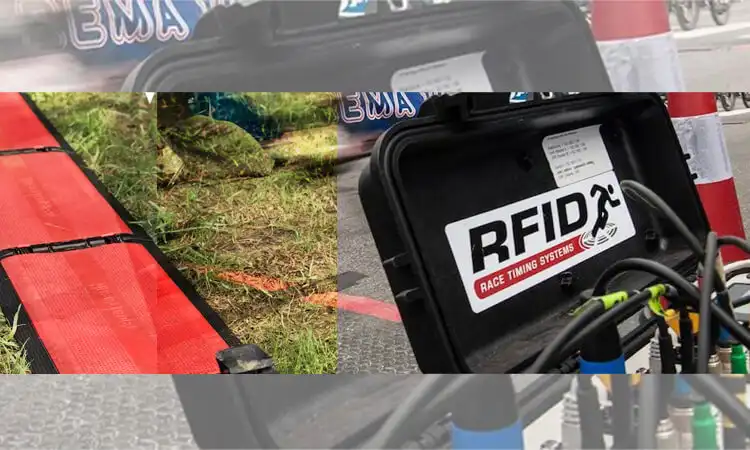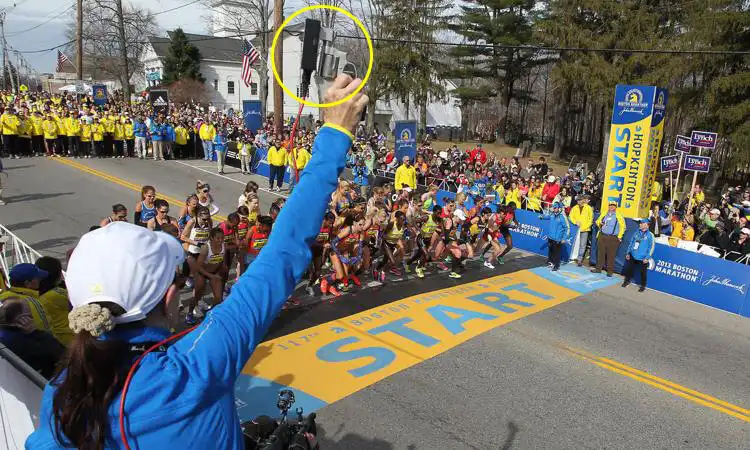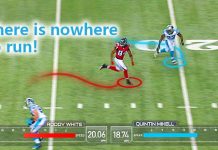Race timing can make the difference between winning and losing. Gun and chip timing are the two most common methods used in races. Gun timing is based on the starting gun, while chip timing is based on when you cross the starting line. Understanding the differences between these two methods is crucial for race participants. In this blog, we’ll explore the pros and cons of each method, how they work, and which is better.
What is Chip Time?
Chip time is a popular method of measuring race times, providing precise and accurate results for race participants. This method uses RFID transponder chips to track racers’ times as they cross RFID timing mats throughout the race course. The RFID chip is attached to the back of the race bib or worn on the shoelaces or ankles, depending on the system used.

In chip time, RFID timing mats are placed throughout the race course, and when a racer crosses over them, the antenna within the mat emits an electromagnetic wave that energizes the RFID chip. The chip then responds with a unique identification number that is associated with the racer’s race bib number, providing accurate and individualized race data. This information is captured by an RFID reader and sent to a computer, which calculates your time from the start to the finish line based on the difference between the recorded time at the starting line and the recorded time at the finish line. This is known as net time.
Larger races will have mats at various checkpoints throughout the race, allowing organizers to measure split times and track racers’ progress. Chip timing has become popular due to its ability to provide accurate individual times even in large crowds and reduce cheating. This is because racers must cross all the checkpoints to have their net time accurately recorded.
RFID was first used in the late 1980s primarily for motor racing and became more widely adopted in athletic events in the mid-1990s upon the release of low cost 134 kHz transponders and readers from Texas Instruments.
— From Wikipedia on the history of Chip Time
What is Gun Time?
Gun time is a traditional and USATF-sanctioned method of timing races, where the race clock starts for everyone at the initial pistol shot, regardless of when you cross the starting line. This means that the time from a pistol shot to the finish line will be your official time.

While gun time is less accurate than chip time, it is still used in many races to uphold the integrity of the competition. The individual at the head of the pack needs to be perceived as being in the first place so that competitors can strategically pace themselves and set up a final kick at the end. Similarly, the individual in first needs to be able to protect their position at the front, which can be challenging if chip timing is used and a faster runner who started in a later wave crosses the finish line first.
Differences between Chip Time vs Gun Time
When it comes to timing races, there are two main methods: chip timing and gun timing. Chip timing uses electronic timing chips attached to athletes or vehicles to record “start and finish” times. In contrast, gun timing uses acoustic sensors and visual timing to record “start and finish” times manually. Overall, chip timing is typically more accurate than gun timing.
One of the advantages of chip timing is that it doesn’t require a clear line of sight between the start and finish lines. Timing chips can operate even if the start and finish areas are separated or obstructed, whereas gun timing requires a clear line of sight for visual confirmation of passing the start/finish lines.
Another advantage of chip timing is that it can handle more participants simultaneously with less chance of timing errors or overlaps. With chip timing, this makes it easier to manage many athletes or vehicles at once.
Additionally, chip timing data can be downloaded directly into race management software for quick results calculation and analysis. In contrast, times from gun timing typically need to be manually entered, which is more time-consuming and can lead to errors.
However, one of the disadvantages of chip timing is that it tends to be more expensive than traditional gun timing equipment. There are higher upfront and ongoing costs associated with chip timing tools and technology.
Another benefit of chip timing is that it allows for intermediate timing points along the course. Multiple timing gates can be set up to record split times at specific locations, making it easier to track athletes’ progress. This type of intermediate timing is difficult to achieve with gun timing.
Finally, chip timing is more precise to the millisecond level, while handheld stopwatches and visual timing typically only record to the hundredth of a second. This level of precision can be important in races where every second counts.
While both chip timing and gun timing have advantages and disadvantages, chip timing is generally considered more accurate, can handle a larger number of participants, and allows for intermediate timing points along the course. However, it is also more expensive and requires specialized equipment and technology. The choice of timing method ultimately depends on factors such as the size and type of the race, the desired level of accuracy, and the available resources.
Here’s a table summarizing the differences between Chip Time and Gun Time:
| Chip Timing | Gun Timing | |
|---|---|---|
| Method | Uses electronic timing chips to record start and finish times | Uses acoustic sensors and visual timing to manually record start and finish times |
| Accuracy | More accurate than gun timing | Less accurate than chip timing |
| Line of Sight | Does not require a clear line of sight between start and finish lines | Requires a clear line of sight for visual confirmation of passing start/finish lines |
| Number of Participants | Can handle a larger number of participants simultaneously with less chance of timing errors or overlaps | Can handle a smaller number of participants |
| Results Calculation | Data can be downloaded directly into race management software for quick results calculation and analysis | Times typically need to be manually entered, which is more time-consuming |
| Cost | Tends to be more expensive than gun timing equipment | Less expensive than chip timing |
| Intermediate Timing Points | Allows for intermediate timing points along the course | Difficult to achieve intermediate timing with gun timing |
| Precision | Provides more precise timing to the millisecond level | Typically records to the hundredth of a second |
How Does it Affect the Results?
In larger races, the difference between net time and gun time can be significant, with up to several minutes passing before a participant actually crosses the starting line. In order to ensure fair competition, the best racers are typically placed at the front of the pack, where they have a more accurate time and don’t have to work their way through crowds. For categories such as age and gender, net time is typically used in lieu of gun time, as it provides a more accurate race result regardless of starting position.
While chip timing is a more accurate and reliable method of timing races, gun timing still exists in racing, especially for smaller races where the discrepancy between net time and gun time is minimal. In addition, some race organizers may prefer to use gun timing for its perceived fairness in competition, as it ensures that the first person to cross the finish line is the winner.
However, many races now use both gun timing and chip timing simultaneously to provide accurate results for all participants. This allows accurate net times to be recorded while upholding the tradition and integrity of gun timing.
Which Timing Method is Better?
Determining which timing method is better, chip timing or gun timing depends on various factors. For smaller races, gun timing may be sufficient. Still, chip timing is often preferred for larger races due to its higher accuracy and ability to handle a larger number of participants. However, gun timing is still used in many races to uphold the integrity of competition, especially for races with large crowds or multiple waves of runners.
The choice between gun time vs chip time depends on various factors, including accuracy, cost, and race size. While chip timing is generally considered more accurate and can handle larger crowds, gun timing maintains the traditional aspect of timing races and may be more appropriate for smaller events. Race organizers should consider the pros and cons of both methods and choose the one that best fits their needs.
Related Reading:
About Chip Time vs Gun Time Problem
-
What are the main differences between chip timing and gun timing?
Chip timing uses electronic timing chips to track racers’ times as they cross timing mats located throughout the race course, while gun timing starts the race clock for everyone at the initial pistol shot.
-
How does chip timing work compared to gun timing?
Chip timing records the time from when the participant crosses the starting line to when they cross the finish line, while gun timing records the time from the initial pistol shot to the finish line.
-
Which timing method is more accurate, chip timing or gun timing?
Chip timing is generally considered to be more accurate than gun timing, especially in larger races.
-
How does timing accuracy differ between chip timing and gun timing in large races?
In larger races, chip timing is more accurate as it records each participant’s net time, while gun timing can be less accurate due to the time delay for some participants to cross the starting line.
-
What are the advantages and disadvantages of chip timing compared to gun timing?
The advantages of chip timing include greater accuracy, the ability to handle larger crowds, and the ability to provide intermediate timing points. Disadvantages include higher costs and the need for specialized equipment. Gun timing is less expensive and upholds the traditional aspect of timing races, but it can be less accurate in larger crowds.
-
How do race organizers choose between chip timing and gun timing for their events?
Race organizers typically consider factors such as race size, desired level of accuracy, available resources, and cost when choosing between chip timing and gun timing for their events.
-
Can chip timing and gun timing be used together in the same race?
Yes, many races now use both chip timing and gun timing simultaneously to provide accurate results for all participants. -
What are the costs associated with implementing chip timing versus gun timing?
Chip timing systems are more expensive than traditional gun timing equipment, with higher upfront and ongoing costs associated with chip timing tools and technology. However, the benefits of chip timing may outweigh the costs for larger races. -
How does chip timing allow for more accurate and detailed race data than gun timing?
Chip timing allows for individual net times, intermediate timing points, and more precise timing to the millisecond level. This makes it easier to track athletes’ progress and provides more detailed race data.
-
How has chip timing impacted the overall experience of participating in races?
The use of chip timing has improved the overall experience of participating in races by providing more accurate results, allowing for larger crowds, providing more detailed race data, and reducing the need for large starting areas.











